You want shock and awe? I was shocked and awed, riding the biggest production V-twin made along a winding road that was dropping thousands of feet from the Inyo Mountains down into Panamint Valley, hustling this 800-pounder along nice new asphalt, occasionally scraping the boards on a turn, heating up the brake discs, generally having a really good time, when all of a sudden—and I mean sudden like NOW!—this huge, gigantic ripping, tearing, gut-searing noise came out of nowhere, beating on my eardrums, rattling my brain. I had not the slightest idea what was happening. Cataclysm? Earthquake? Engine self-destructing? Being overtaken by a twin-turbo Kenworth tractor?
None of that, just an F/A-18 pilot about 100 yards off to my left having fun spooking motorcyclists on his way to a China Lake bombing run.
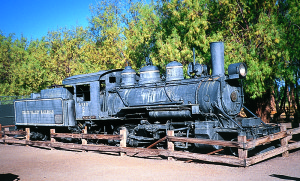
That fighter plane was big, fast, powerful—as was my ride, a Kawasaki Vulcan 2000. But the pilot had wings, I didn’t, so all I could do was watch him as he headed down, down into the valley, probably at a modest 400 mph. Sort of cool, watching that twin-engined craft get way lower than where I was. By this time I had come to a stop, and realized he had a wingman flying just a little farther off. I have heard it is a real kick, piloting one of those…as is riding one of these big two-cylinder two-wheelers.
A big bike wants big country. I had run Vulcan, the name taken appropriately from the Greek god of fire and the forge, up and down the coast, all around my particular neck of the woods, but I needed some open road, some space, in order to thoroughly appreciate the virtues of this Brobdingnagian motorcycle, and what better time and place than a trip out to the desert. Kawasaki had bolted on a windshield and a pair of saddlebags to turn the bike into a touring cruiser. I had a new rear tire mounted, tightened up the preload on the rear shock, clicked the damping two notches, checked the oil and coolant levels, topped off the tank, and I was set.
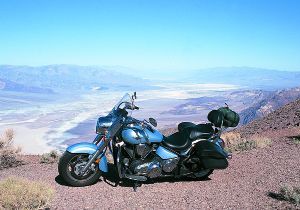
“My, that’s a pretty motorcycle,” said the lady filling up her Camry at the pump next to me. Flattery is good, but will it get me to Death Valley, California, ZIP code 92328, area code 760? With me and my gear on board, my rolling dreadnought weighed well over half a ton—still nowhere near the 1,226-pound GVWR.
I’m rather fond of Death Valley National Park, which is really a series of valleys separated by mountain ranges, and the gloomy name is quite undeserved. Back in 1849 a wagon-train leader, taking 27 wagons to the California goldfields, decided he could do better than the route marked on his AAA map and said he knew a good shortcut…through this as yet unnamed valley. They spent a few weeks getting unlost, but only one person died, and that was because he went off by himself instead of sticking with the crowd.
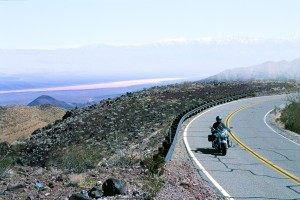
I first rode into Death Valley in 1967, on a Triumph TR6, and have been back 40 times or more. I am amused by the people who say they’ve been there, once, seen it, no need to go back. Perhaps they prefer Disneyworld, with whirly rides and cotton candy. Me, I like the roads, the views, the history—there is always something new, something different.
Death Valley has many approaches, of which six are paved, with at least half a dozen others ranging from good gravel to really gnarly rock-strewn roads and sandy tracks. With Vulcan as my fiery steed I would stick to the pavement, since he suffers limited ground clearance, and limited suspension travel.
My favorite way into the valley is via the wide spot in the U.S. 395 road called Olancha, where I met a couple of friends for lunch at the Ranch House Café—good grub, better than anything in the park. While still digesting the Indian fry-bread special we saddled up and turned onto CA 190, skirting the dry Owens Lake with 14 miles of straight pavement—Vulcan and I covered that in seven minutes. Turning right at the stop sign, we started a climb up to the Darwin Plateau, on top of the Inyo Mountains. I’ve ridden a lot of bikes, a lot of big bikes, but I have never been more aware of the power of torque than on this 2,053cc (125 cubic inches, if you want to go American) engine. Who cares about 90-some piddling horsepower when 120 footpounds of torque are available at 3,400 rpm? Any gear, any time, turn the throttle, and I got that F/A-18 surge. It is impressive, and makes all the other big, pushrod V-twins look positively puny. Sorry, guys, that’s the way it is. There are some “built” motors that will tear your arms off, but this one is box-stock and warrantied.
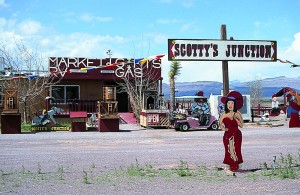
We ignored the turn to Saline Valley, having no interest in doing 80 miles of dirt road. The big sign welcoming us to Death Valley is up on that plateau, at about 5,000 feet, followed by the 3,500-foot drop, on a deliciously curvy road down the east escarpment to Panamint Dry Lake. That’s where I got overtaken by the flyboy. Brakes are very important on this road, and Vulcan has got strong stoppers on the front wheel, a pair of 300mm discs with four-piston calipers. These require an authoritative pull, which is what cruiser riders like, and work just fine.
We met up with some more friends at the little Panamint Springs resort, and watched the jet jockeys loop around the valley while we had a soda. Remounting, we headed off on the long straight across the valley, and up to Towne Pass at 4,956 feet, a good piece of steepish road with long sweepers. I was climbing in fourth gear with not a care in the world, going past the occasional laboring family crammed peoplemover. Over the pass and down into Death Valley proper, past Stovepipe Wells, on to Furnace Creek. There was the SEA LEVEL sign, then 100 FEET BELOW SEA LEVEL with a couple of cars full of Germans posing for pictures.
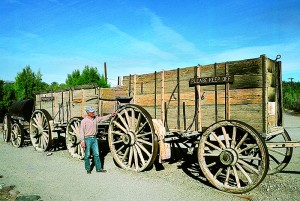
Furnace Creek Ranch is the park headquarters, and tourist headquarters as well. The Xanterra company has the concession franchise, offering over 200 rooms, from modest cabins for $105 in the hot season, to bungalows for $175 in the cool weather between October and April. Gas, groceries, mediocre food, saloon—everything is available, including the world’s lowest golf course, at $55 a round of 18 holes. Motorcyclists love the place, and clubs come from all over the southwest to rendezvous, make noise, maybe ride to Zabriskie Point on a moonless night.
Morning came clear and calm, not a breeze to riffle the palm leaves. Half a dozen of us rode up to Dante’s View, at 5,475 feet, to get a good view of Death Valley, over a mile below us; that is an impressive sight. As well as an impressively twisty road to get to the top, and Vulcan’s 68.3-inch wheelbase did remind me that this was not a quick-steering machine. In my over-exuberance I found that the bottom muffler could be thoroughly scraped.
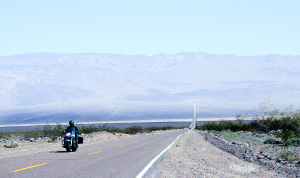
After Dante we continued up Furnace Creek Wash to Death Valley Junction and the Amargosa Opera House. A dancer named Marta Becket has been putting on shows in this old railway-workers meeting hall for the past 40 years—if you have the chance, do go and see her perform. Her work is the absolutely beautiful antithesis to what you see in Las Vegas, a mere 80 miles away. However, at 9 o’clock in the morning, nobody was around.
We kept south through the Amargosa River valley for a brisk 15 minutes, ending up in Shoshone, a village with a general store, gas station and one café. Good café, too, with an excellent breakfast served by a cheerful waitress. A Vulcan 1500 owner was just leaving as we arrived, so while my friends ordered for me, he and I swapped bikes and went down the road a couple of miles. “Got a lot of guts,” he said, after his brief spin. Truer words were never spoken.
We went back to Furnace Creek on CA 178, via Salsberry and Jubilee passes, and Badwater. That is a stretch of lonely road indeed; the fuel-injected V-twin was breathing quite happily at 280 feet below sea level. After such a hectic morning I was glad to go and loiter by the swimming pool for an hour or so. Our group was going to dine at the Stagecoach Inn & Casino in Beatty, Nevada, that evening.
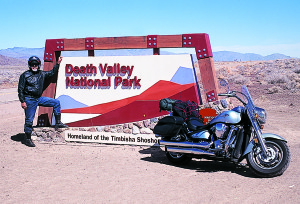
I decided to take the long way to get there—it was 40 miles the short way, 115 the long, via Scotty’s Castle. The 3,000-foot climb up to Scotty’s place is subtle, as it stretches out over 50 miles, and the Two-Liter Limo took it all with ease. Big torque, enhanced by the long stroke; crank it on in any gear, and those axle-twisting foot-pounds have you leaning backward. I liked the belt drive, as it delivers the power more smoothly, and cleanly, than a chain. Having been into Walter Scott’s little castle before, I did not sign up for an inside tour, but anybody not knowing the background to the story needs to go—the place is an entertainment.
From there Vulcan and I headed up Grapevine Canyon, crossed into Nevada, and out onto the Sarcobatus Flats and Scotty’s Junction. This is certainly the Big Nothing, and we trundled along at a steady 80 per until the Bullfrog Mountains sppeared close up as we headed into Oasis Valley, leading into Beatty, a mining town fallen on hard times. On the outskirts was the Stagecoach Inn, one of those quick-built establishments that look good for the first 10 years, and then decay rapidly. The ching-ching of the one-armed bandits greeted me, and a few people were at the blackjack tables. Myself, I’ve nothing against a good game of poker, but the pleasure that some folks find in these casino operations entirely escapes me. Dinner was nothing to write home about, either.
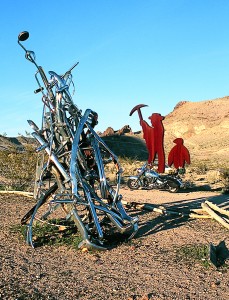
Afterward, in the dark, we all rolled back past the old Bullfrog Mine and the 10 ruler-straight miles across the Amargosa Valley, with many dips in the road, headlights appearing and disappearing as they came toward us—just a little bit eerie. Over Daylight Pass at 4,317 feet, down 2,000 feet to Hell’s Gate, then we took the cut-off toward Furnace Creek.
In the morning it was time to leave, and we went out via Emigrant Pass (5,318 feet) and down Wildrose Canyon into the south end of Panamint Valley—another long straight, dead flat run. Vulcan decided to show me the 130-mph mark on the speedometer; here we might have given that F/A-18 a run for its money. We climbed over the Slate Range, down into Searles Valley and the declining company town of Trona—eponymously named after the mineral mined there. Up Poison Canyon, over the Spangler Hills, and down into Fremont Valley. Hook into Highway 58 at Cache Creek, and home was a mere three hours away.
It was a good trip, and Vulcan loved the whole process, long valley roads, lots of tight turns in the mountains. Did I need 2,053cc? Certainly not, but bigger is more fun, just like Death Valley.
Note: Since I took my trip Death Valley has suffered some horrendous weather, and several of the roads I was on have been closed. You can call park headquarters at Furnace Creek, (760) 786-2331, to get the latest updates.
(This article MOUNTAINS & VALLEYS: RIDING THE VALLEY OF DEATH ON THE GOD OF FIRE was published in the May 2005 issue of Rider magazine.)
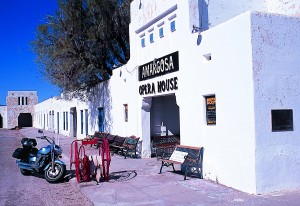 |
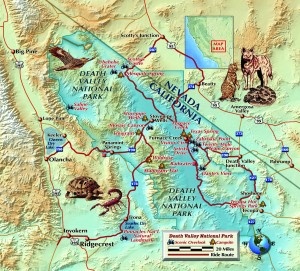 |








All the comments about the ‘Vulcan’ ruin the story, also makes the writer appear as a novice rider.
The story is about riding a cycle through Death Valley, no one cares what you rode.
That you feel the need to constantly explain how ‘powerful’ the Vulcan is in nearly every paragraph makes it look weak as you need to constantly reinforce its supposed superiority to the reader.
This is an AD for the Kawasaki Vulcan. Come on! Kawasaki Vulcan? Give me a break.